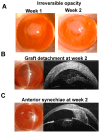Assessment of Corneal Graft Outcomes in a Murine Model of Endothelial Keratoplasty
- PMID: 39274223
- PMCID: PMC11396379
- DOI: 10.3390/jcm13175010
Assessment of Corneal Graft Outcomes in a Murine Model of Endothelial Keratoplasty
Abstract
Objectives: In this study, we establish a protocol for evaluating the outcomes of endothelial keratoplasty, including graft survival, rejection, or failure. Additionally, we also evaluate the alloimmune response in graft recipients. Methods: We performed EK using C57BL/6 (allogeneic) and BALB/c (syngeneic) as donors and BALB/c mice as recipients. Slit-lamp examination and optical coherence tomography were performed for clinical evaluations for 16 weeks post-procedure. Criteria for the assessment of corneal opacity were established and the animals were graded weekly. Additionally, we assessed corneal endothelial cell density by harvesting the corneas and staining with zonula occludens-1 (ZO-1). Lastly, lymph nodes were collected, and CD4+ T cells were MACS-sorted and co-cultured with syngeneic or allogeneic antigen-presenting cells (APCs) to assess the IFN-γ expression levels by alloreactive Th1 cells (ELISPOT) in response to the direct (donor) or indirect (host) pathways of sensitization. Results: We observed graft failure in four animals, including irreversible corneal opacity, graft detachment, and anterior synechiae in the first four weeks. The remaining animals were graded between 0 and 5 as per the established criteria. The total and graft corneal thickness and endothelial cell density progressively worsened with a higher grade of corneal opacity. The direct allosensitization of Th1 cells was significantly higher in mice with a higher grade of corneal opacity. At 16 weeks follow-up, the grafts remained stable with low opacity scores in syngeneic EK recipients; however, the opacity scores were higher and variable in allogeneic EK recipients. Conclusions: These findings establish a standardized protocol to assess the graft outcomes in a murine model of EK. Furthermore, we delineate the underlying immunological pathway that contributes to the immune-mediated rejection of grafts in this model.
Keywords: endothelial keratoplasty; graft failure; graft rejection; murine model.
Conflict of interest statement
The authors declare no conflicts of interest.
Figures






References
-
- Zhu J., Inomata T., Di Zazzo A., Kitazawa K., Okumura Y., Coassin M., Surico P.L., Fujio K., Yanagawa A., Miura M., et al. Role of Immune Cell Diversity and Heterogeneity in Corneal Graft Survival: A Systematic Review and Meta-Analysis. J. Clin. Med. 2021;10:4667. doi: 10.3390/jcm10204667. - DOI - PMC - PubMed
Grants and funding
LinkOut - more resources
Full Text Sources
Research Materials
Miscellaneous

